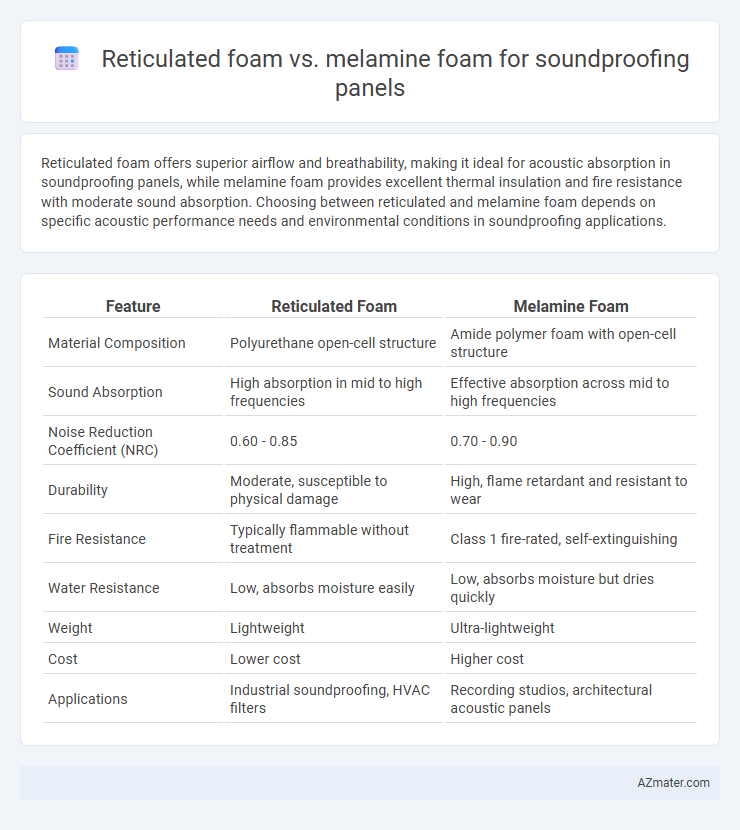Reticulated foam offers superior airflow and breathability, making it ideal for acoustic absorption in soundproofing panels, while melamine foam provides excellent thermal insulation and fire resistance with moderate sound absorption. Choosing between reticulated and melamine foam depends on specific acoustic performance needs and environmental conditions in soundproofing applications.
Table of Comparison
| Feature | Reticulated Foam | Melamine Foam |
|---|---|---|
| Material Composition | Polyurethane open-cell structure | Amide polymer foam with open-cell structure |
| Sound Absorption | High absorption in mid to high frequencies | Effective absorption across mid to high frequencies |
| Noise Reduction Coefficient (NRC) | 0.60 - 0.85 | 0.70 - 0.90 |
| Durability | Moderate, susceptible to physical damage | High, flame retardant and resistant to wear |
| Fire Resistance | Typically flammable without treatment | Class 1 fire-rated, self-extinguishing |
| Water Resistance | Low, absorbs moisture easily | Low, absorbs moisture but dries quickly |
| Weight | Lightweight | Ultra-lightweight |
| Cost | Lower cost | Higher cost |
| Applications | Industrial soundproofing, HVAC filters | Recording studios, architectural acoustic panels |
Introduction to Acoustic Foam Materials
Reticulated foam and melamine foam are common acoustic foam materials renowned for their sound absorption properties. Reticulated foam features a highly porous structure that facilitates airflow and captures mid-to-high frequencies effectively, making it suitable for soundproofing panels in environments requiring noise reduction. Melamine foam, known for its open-cell framework and fire-resistant characteristics, excels at attenuating a broad range of frequencies while maintaining lightweight and durable properties ideal for professional acoustic treatments.
What is Reticulated Foam?
Reticulated foam is a highly porous and open-cell material, created by removing cell membranes through a thermal or chemical process, which allows maximum airflow and sound absorption. Its structure makes it ideal for acoustic panels intended to reduce echo and reverberation by trapping sound waves effectively. Compared to melamine foam, reticulated foam offers superior breathability and durability, making it a preferred choice for high-performance soundproofing applications.
What is Melamine Foam?
Melamine foam is an open-cell, lightweight acoustic material made from melamine resin, offering superior sound absorption and thermal insulation properties. Unlike reticulated foam, which has a coarse, porous structure designed primarily for air flow and filtration, melamine foam provides fine, dense cell structures that effectively dampen mid to high-frequency sound waves. Its fire-resistant and moisture-resistant characteristics make melamine foam an ideal choice for soundproofing panels in residential and commercial environments.
Sound Absorption Properties: Reticulated vs Melamine
Reticulated foam offers high porosity with open-cell structure, enabling excellent sound absorption primarily for mid to high-frequency noise. Melamine foam features a unique rigid, open-cell network that excels in absorbing a broader frequency range, including both mid and low frequencies. Compared to reticulated foam, melamine foam typically provides superior acoustic attenuation and fire resistance, making it a preferred choice for advanced soundproofing panels.
Durability and Longevity Comparison
Reticulated foam offers higher durability and longer lifespan compared to melamine foam, as its open-cell structure resists tearing and deformation under prolonged use. Melamine foam, while effective in sound absorption, tends to be more brittle and susceptible to wear, reducing its longevity in high-traffic or demanding acoustic environments. Choosing reticulated foam ensures more sustained performance and cost-efficiency for soundproofing panels over time.
Fire Resistance and Safety Ratings
Reticulated foam offers excellent fire resistance with a high ASTM E84 Class A rating, making it suitable for stringent safety requirements in soundproofing panels. Melamine foam is inherently fire-resistant due to its closed-cell structure and consistently achieves UL 94 V-0 ratings, ensuring non-flammability and low smoke emission. Both materials meet critical fire safety standards, but melamine foam provides superior thermal stability and reduced toxic gas release during combustion, enhancing overall panel safety.
Ease of Installation and Customization
Reticulated foam offers superior ease of installation due to its open-cell structure, allowing it to be easily cut and shaped to fit various panel designs without compromising acoustic performance. Melamine foam, while lightweight and fire-resistant, can be more brittle and challenging to customize, often requiring specialized tools to achieve precise cuts for soundproofing panels. The flexibility of reticulated foam makes it the preferred choice for projects demanding quick, adaptable installation and tailored acoustic solutions.
Cost Effectiveness Analysis
Reticulated foam offers a cost-effective solution for soundproofing panels due to its open-cell structure, which promotes airflow and efficient sound absorption at a lower material cost compared to melamine foam. Melamine foam, although more expensive, provides superior fire resistance and higher durability, potentially reducing long-term replacement expenses. Evaluating the total cost of ownership, reticulated foam is preferable for budget-conscious projects prioritizing basic sound absorption, while melamine foam suits applications demanding enhanced safety and longevity despite higher initial investment.
Applications in Soundproofing Panels
Reticulated foam, characterized by its open-cell structure, excels in high-frequency sound absorption and is commonly used in industrial noise control panels and HVAC systems to reduce airflow noise. Melamine foam offers superior acoustic performance across a broader frequency range, making it ideal for professional recording studios, home theaters, and office soundproofing panels. Both foams are lightweight and fire-resistant, but melamine foam's finer pore structure provides enhanced sound absorption and durability in architectural acoustic treatments.
Choosing the Right Foam for Your Acoustic Needs
Reticulated foam features an open-cell structure ideal for applications requiring high airflow and durability, making it suitable for advanced sound absorption and filtration tasks. Melamine foam boasts superior noise reduction properties with excellent fire resistance and lightweight characteristics, preferred for standard acoustic panels in studios and offices. Selecting between reticulated and melamine foam depends on specific acoustic goals, environmental conditions, and regulatory requirements for soundproofing effectiveness.

Infographic: Reticulated foam vs Melamine foam for Soundproofing panel
 azmater.com
azmater.com